If I earned a gold coin for every time a parent complained about their child’s love of video games, I would have stormed the castle, defeated the castle warlords, and earned magical powers to advance me to the next level by now (because what else are gold coins for in video games?)
The creators of Habitica would, too. They know the draw that earning gold coins, buying armament, and defeating monsters can have. That’s why they’ve created an app that links your to-do list and habits with precisely these kinds of things. To find out more, fellow coach Dan Messier and I decided to try this app out to see if it’s worth introducing to our coaching students. (We're always looking for new ways to help put the fun in executive function.)
The Functions
At its core, Habitica has three main ways you can organize things: Habits, Dailies and To-Dos.
Habits is the place where you write down things that you want to become habits, but are not there yet. I added “Flossing” onto mine. It’s one of those things I know I should be doing, but do so with irregularity (go ahead -- heckle me like my hygienist does). Every time I floss, I click the plus sign and earn points. Whenever I skip, I click the minus sign (and lose health points both in the game and most likely in real life).
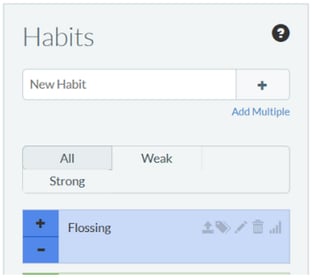
Dailies is the place where you add tasks that are on repeat, such as walking the dog. You can also add tasks that occur each week, but not every day of the week, such as trash collection day. If they are blue, that means they are active (and need to be checked off that day). If they are gray, they are inactive. If they are gray with a checkmark, you’ve done it! So, at the time of this post I had exercised my dog, but hadn’t done a training session with her yet. It also wasn’t a day that I go to the gym or need to set my fantasy football lineup (anyone else forget about Thursday night games?).
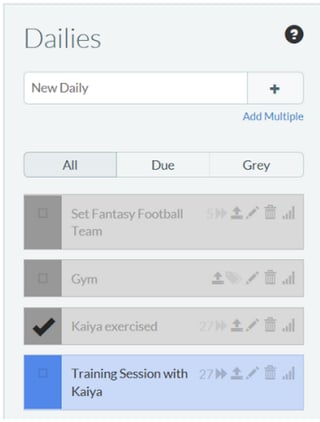
To-Dos is the place where you add things that need to get done just one time. You can add due dates, assign a level of difficulty, and even add sub-tasks to check off as you go. The longer a task stays on your to-do list, the redder it becomes. By the time you’re reading this post, I’ll have checked off the first item on my list! (And hopefully that angry red one about progress reports).
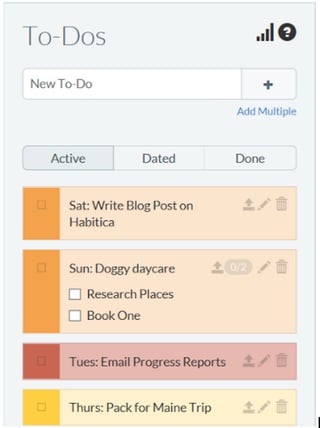
The Features (Or, The Fun)
Here’s where the fun part comes in: each time you check an item off your list, you earn gold coins and experience points. The more experience you gain, the closer you are to leveling up. The more gold coins you earn, the more equipment you can buy. Why would anyone want to do this kind of stuff? To participate in Quests. Now, this isn’t like your typical “questing” where you could actually spend time fighting monsters (and thus avoid doing the things on your to-do list). In Habitica, a quest means that throughout the day, the things you check off on your list “hurt” the list-hungry monsters. The things that don’t get checked off -- especially daily tasks -- “benefit” the list-hungry monsters (and damage your health points). The quest is there to encourage you to get as many things checked off your list as you can to defeat the list-hungry monsters (and earn more gold, level up, and eventually move onto other cool things like getting pets, mounts, and more quests).You can also battle these monsters with friends. My colleague, a coaching client, and I have synced up, and it means that all of us are checking things off our lists to defeat monsters together. While I cannot see their actual to-do lists (like I could with Wunderlist), I can see the last time they logged on, their stats (health, experience, level), and what they’ve contributed to defeating the monsters (the more points, the more things they’ve accomplished on their to-do lists).
The Faults
There are a few downsides to the program that are worth mentioning. The biggest one I see as an executive function coach is the fact that you cannot prioritize or color-code your tasks. One way I’ve gotten around this is to order the tasks in terms of priority by moving where they are on the list. Another issue is 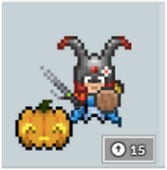 that you can set due dates, but you can’t set when you’ll do them. To work around this, I start the name of the task with the day of the week that I will do it (so, Wed: Fold Laundry; Fri: Grocery Shop). Finally, you can’t set reminders to do things. When I first started using this program, I left the site open on my laptop and the app on the homescreen on my phone for visual reminders. I also selected a “log on” tune which played every time I logged onto my computer which served as an auditory reminder to click over to the site. It took some time, but now I check it multiple times a day. It might also be worth noting that the graphics aren’t great. You can see my blurry avatar here on the left. I realize that some serious gamers might not be thrilled with this.
that you can set due dates, but you can’t set when you’ll do them. To work around this, I start the name of the task with the day of the week that I will do it (so, Wed: Fold Laundry; Fri: Grocery Shop). Finally, you can’t set reminders to do things. When I first started using this program, I left the site open on my laptop and the app on the homescreen on my phone for visual reminders. I also selected a “log on” tune which played every time I logged onto my computer which served as an auditory reminder to click over to the site. It took some time, but now I check it multiple times a day. It might also be worth noting that the graphics aren’t great. You can see my blurry avatar here on the left. I realize that some serious gamers might not be thrilled with this.
To get a feel for the dashboard as a whole, here’s a screenshot of mine:
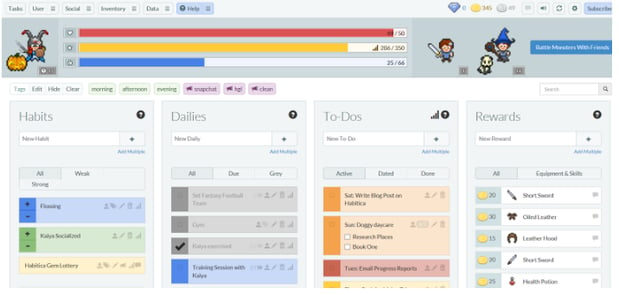
So, if you or your child have what feels like a never-ending to-do list - I recommend giving this one a shot. It definitely feels good checking things off your list. It feels even better when gold coins come along with it.
Note: This is an unsolicited review of Habitica. Beyond BookSmart was not compensated in any way from Habitica for this post.
Is your child an expert at video games but struggling with school? Help your child recognize similarities between skills required in the gaming world and skills required in real life. Click below to download our tips for partnering with video games.

